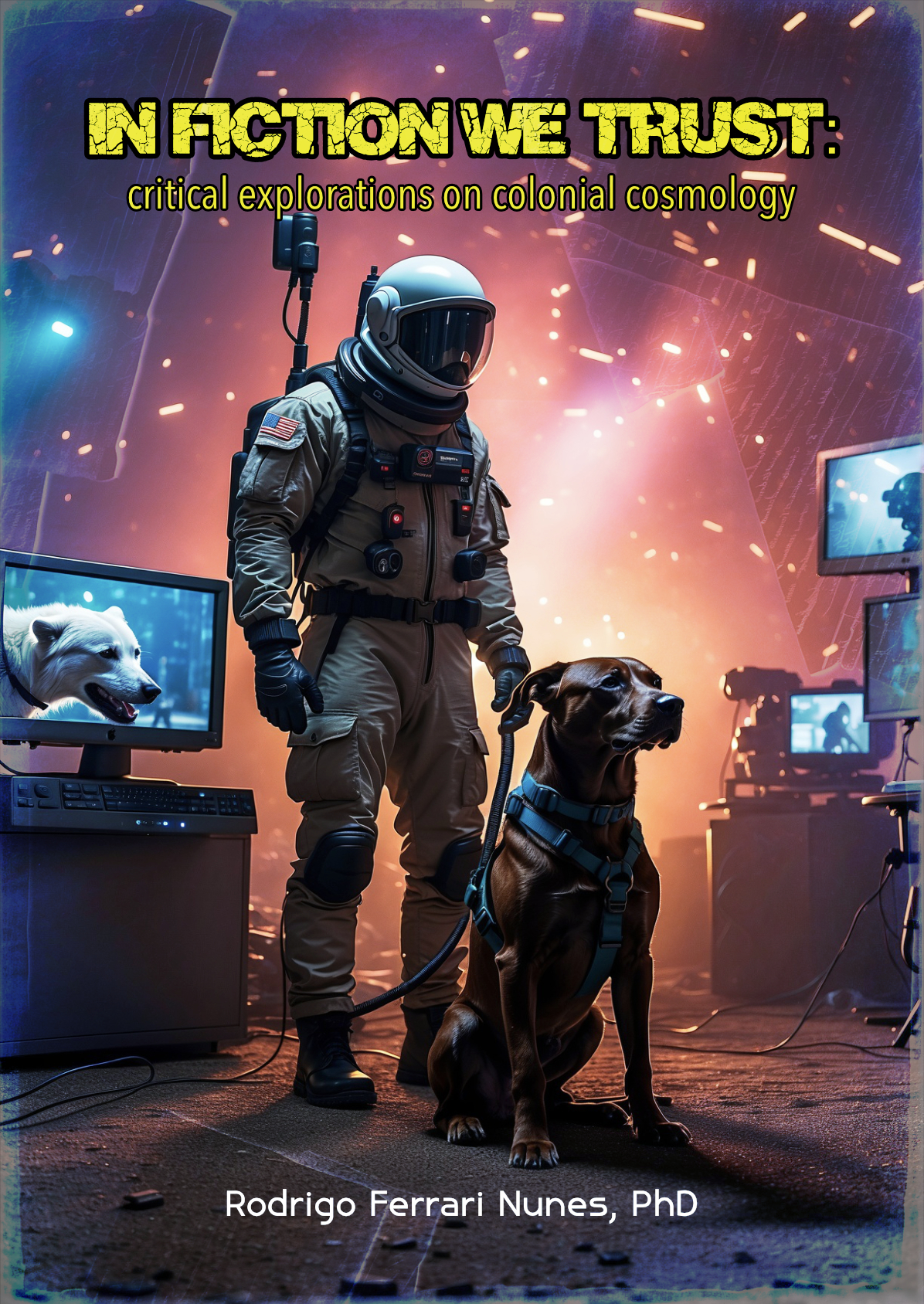
INVISIBLE NAZI METAMORPHOSES
Project Paperclip brought many so-called Nazi scientists to the United States. Despite their documented Nazi fanaticism and cruel crimes, including overworking prisoner-slaves, torturing and killing them in pressure chambers, they were pardoned in support of the alleged space exploration lore within the Cold War script. The logic for this pardoning is completely spurious and senseless. As criminals, they should have been tried and punished accordingly. Yet, once they crossed the American magic portal, their troublesome pasts vanished. State propaganda, aligned with the prestige of the rocket scientist label made them so culturally important that their crimes were forgotten, and they were left unpunished. For instance, Annie Jacobsen wrote that as “man” allegedly got “closer and closer” to the Moon:
Wernher von Braun enjoyed a parallel ascent in fortune and fame. Because von Braun was a public figure, his Nazi past was always there, but in shadow.1
To the masses who were passively absorbing space age propaganda, von Braun became some mystical genius, a god of science. And up until the twentieth first century, believers were led into thinking that such a criminal, who overworked slaves and produced weapons of mass destruction, was somehow working for peace and for pushing the frontiers of space exploration, whatever that was supposed to mean. People used their imaginations to fill in the gaps, and it all worked like magic. Critics were always countered with some bullshit that had more promotional power behind it, and their critiques were sidelined.
As the space propaganda materials from the 1950s make it clear, people were motivated to join and support the newly invented space age through fear mongering and the prospects of aggressive wars and the domination of other peoples. The idea was to establish the United States as the ultimate world power, followed closely by Russia, which became a perennial boogieman. The Cold War script followed closely George Orwell’s 1984 model, ensuring that the State and its crooked politicians would be constantly worshipped by a misinformed and ignorant population. Thus, the fiction of an ever evolving, progressive State, heading to the stars, was forged in the public imagination. This control formula combined the goals of imperialism, such as the constant glorification of the colonial State, into a science fiction story presented as real and unquestionable, again and again.
One key source of information for this early period of space exploration lore is Collier’s, a popular American magazine. The March 22nd 1952 issue, for instance, is entitled Man Will Conquer Space Soon: Top Scientists Tell How in 15 Startling Pages.2 It presents both von Braun and Heinz Haber, another Paperclip Nazi, as scientists brought from Germany. This magazine issue and its many follow ups represent a monumental effort in State propaganda, wrapped around space age fairy tales and spiced with boogieman-style fear-mongering. Collier’s magazine goes out of its way in order to enhance the impression of authority of these alleged space exploration pioneers among the population. Here is how the popular magazine portrays the former war criminals as current science heroes:
Dr. Wernher von Braun, Technical Director of the Army Ordnance Guided Missiles Development Group. At forty, he is considered the foremost rocket engineer in the world today. He was brought to this country from Germany by the U.S. government in 1945.
Dr. Heinz Haber, of the U.S. Air Force’s Department of Space Medicine. Author of more than 25 scientific papers since our government brought him to this country from Germany in 1947, Dr. Haber, thirty-eight, is one of a small group of scientists working on the medical aspects of man in space.
Haber was described as a “Space Medicine” scientist. He was not as well known as von Braun, but his academic work strongly suggests that subjected prisoners to pressure chambers in order to describe the horrific consequences of exposure to lower and higher pressures. He was a sadistic criminal, but was soon working alongside Walt Disney to make up stories for the production of cartoons about atomic power.
According to Jacobsen, Wernher von Braun, like others, “worked carefully to whitewash his Nazi past.”3 In 1960, a sanitized biopic, I Aim at the Stars was released.4 This film pioneered the biopic genre in cinema as a myth-making manipulation technique. It made perfect sense under the MK Ultra regime. MK Ultra was a mass indoctrination program that was imported into the United States from Nazi Germany. It became stronger under the auspices of the so-called intelligence community. Von Braun’s biopic yielded enough propaganda power to bury and silence any resistance to his newly fashioned space explorer hero persona. He was cast to become one of the most important heroes of the Space Age, responsible for putting men on the Moon. The biopic was heavily promoted for decades to come, remaining as an integral part of American television programming. Soon, the public believed von Braun was one of the purest and most inspired scientists in the history of the universe, a visionary star gazing luminary. A version of the biopic is still available on YouTube. A YouTube user named TralfazConstruction remembered seeing I Aim at the Stars on television in the 1960s:
For a couple of years in the mid-60s this movie was a staple feature on the CBS affiliate, Channel 10 in Philadelphia, The Early Show which ran from 4PM ET up until the evening news at 6PM. I had to have seen this at least four or five times over a three year span or so. Another movie which got a lot of repeated broadcasts was Teenagers from Outer Space (1959) which is now seen as nostalgic, campy and a zeitgeist from the era.
Von Braun’s new character was raised to such a mythical position, deserving of a Hollywood biopic, almost a decade before the production of the Apollo 11 television show. As a form of damage control, it helped to muddy the waters surrounding the new American darling’s criminal past. For the believers who took the biopic to heart, von Braun was caught between a rock and hard place during World War II, forced to work for Hitler against his will. None of that is true, of course. As Jacobsen pointed out:
Just as many of Hitler’s scientists would soon become American scientists, so would many of the Reich’s headquarters and command posts become key facilities used for Operation Paperclip.5
A more accurate summary of Wernher Von Braun’s career would be quite different: Wernher von Braun, member of the SS cavalry unit since 1933, Nazi Party member since 1937, promoted to SS officer in 1944, loved to wear his SS officer uniform, “with its swastika on the armband and its cap with the death-head image.”6
Turning war prisoners into slaves, von Braun made them work “twelve-hour shifts, seven days a week, putting together V-weapons,” that is, ballistic missile rockets for Hitler.7 At one point, he cramped “eight thousand men living and working” in the underground with “no fresh air in the tunnels, no ventilation system, no water, and very little light,” and also “no washing facilities and no sanitation.”8
As “walking skeletons” the prisoners were like “skin stretched over bones,” some died from “starvation, dysentery, pleurisy, pneumonia, tuberculosis, and phlegmasia from beatings.”9 Others “perished from ammonia burns to the lungs” or were “crushed from the weight of the rocket parts they were forced to carry.”10 As a result, thirty-thousand prisoners perished, about half this number went to work for von Braun. Yet, the illusion that von Braun was just an innocent, Disney backed scientist about to usher the exploration of space was never fully realized. As Annie Jacobsen noted:
[T]he dark shadow of von Braun’s complicity in Nazi war crimes followed him around. Sometimes it snuck up on him from behind. One day, while visiting the Collier’s office, he was riding the elevator with fellow Paperclip Scientist Heinz Haber, from the School of Aviation and Medicine at Randolph Air Force Base, and Cornelius Ryan, his editor. Also in the elevator were a few Collier’s magazine staffers, one of whom reached out to Haber, rubbed a piece of the scientist’s leather coat between his fingers, and said wryly, “Human skin, of course?”11
Heinz Haber also worked alongside Disney. He took part in animations designed to impress the public with elements of the State’s power mythology, namely atomic power and space exploration stories. He was whisked into the United States and became another character in Disney pseudo-educational films sponsored by the United States government. From then on, the collaboration evolved into what would later become a traditional industry of manipulation, promoting predesigned slogans and pseudo-logical motifs. Once the basic structure and its key formulae had been set, no major innovations followed. Instead, manipulators turned effective strategies into major themes that branched into an infinity of variations. These were promoted heavily to generations of believers.
WOLVES IN SHEEP’S CLOTHES
At last, the Nazi scientists were effectively in disguise. As new public personas, they were backed by a powerful, Edward Bernays-inspired, well oiled and tested propaganda machine. Their main task was to produce cultural materials promoting the space exploration narrative, glorifying politicians alongside the State and its fictional power. The impression that von Braun and his cronies were pioneering geniuses ushering a new age of space exploration and cosmic colonial expansion captured generations of believers to come.
As time moved on, the ex-Nazis became quite comfortable with their roles. The so-called space age went on as a set of stories and productions. The stories became more daring, unrealistic and flamboyant while the public, stayed captured in a fantasy. As hopeful believers, the public was unwilling and unable to question or inspect any aspect of these stories. Von Braun and other Paperclip men wrote books and magazine articles, gave lectures, were featured in animations, television shows and documentary films. They helped to saturate the public imagination with magical just-so stories and fictional promises.
Believers just had to keep on believing. As long as they never realized they were being fed fictions, they would keep hoping that a major technological revolution was just around the corner, freeing them from the alleged shackles of the Earth and its unavoidable destruction. They feel so small and limited in the pale blue dot, the minuscule spinning ball planet they think they live on. Space exploration stories allow them to imagine a whole new universe of possibilities, with space tourism eventually taking them to explore other fanciful gravity balls in the vast expanding cosmos, populated with science fiction characters and races, mere parodies of human cultures.
The standard evidence for space exploration eventually became solidified as the cartoons, animations and scripted studio productions presented to the public. The more propagandists promoted this mythology, the lesser it was questioned. Critics became small and culturally irrelevant. Despite being right, their impact was minimal. For instance, the Black Panther leaders noted at the time of the Apollo 11 production that it was all a government spectacle meant to distract people from the real problems on the ground and the pointless Vietnam conflict.12 They were correct. Regardless, people were happily and easily mesmerized by the glorious story and its shoddy productions.
Soon, space exploration lore, for the glory of the State and the industries that control it, was solidified as an integral part of modern American nationalist cultural mythology. This allowed various related storylines to flourish, despite their shoddy logics and non-verifiability. As specialists and analysts broke down the obvious production techniques space storytellers used, a constant barrage of propaganda kept being poured onto the public, with clownish and repetitive astronauts answering scripted questions to schoolchildren. The stories, unchecked for decades, provided so much fiction presented as reality that believers automatically see all doubters as lunatics.
Finally, the space exploration illusion became almost completely irresistible. With time, the narrative became so ubiquitous that any critic would be flooded by automatic expressions of prejudices and unjust socioeconomic sanctions. Some countries, such as Russia and eventually China, emulated the obvious production techniques that the believing public had become so used to believing. Other countries, such as the United Arab Emirates and Israel, purchased a franchise package from JPL and NASA and proceeded to use the same easy production techniques and storylines with the intent to supposedly inspire their populations with cosmic colonialism and national pride.
OUR FRIEND THE ATOM: CASTING NAZIS AS SPACE SCIENCE HEROES
In 1956 Walt Disney contracted former Nazi war criminal Heinz Haber to write the story of atomic power which his company would animate and promote. With Haber as the main author, Disney released an animation and book with the same name.13 The full title is The Walt Disney Story of Our Friend the Atom.14 Disney himself wrote in the foreword:
The story of the atom was assigned to Dr. Heinz Haber, Chief Science Consultant of our Studio. He is the author of this book and he helped us in developing our motion picture.15
Disney admitted to being committed to bridging science and storytelling. The audience, unsuspecting of any biases, believed the material to be expert illustrated science, relaxing any critical skills they might have.
[W]e don’t pretend to be scientists — we are story tellers [and] combine the tools of our trade with the knowledge of experts.16
Disney “even created a new Science Department at the Studio to handle projects of this kind.”17 Having worked to the United States government throughout World War II, Disney would continue making highly profitable, well-produced animated propaganda films. Playing along with the government’s propaganda program was instrumental in turning Walt Disney into an American icon, with his megalomaniacal theme park projects, infused with an eugenicist and colonialist narrative of Western expansion and triumph.
The Story of Our Friend the Atom was published just about a decade after the end of World War II. Yet, its authors avoid explaining Heinz Haber’s Nazi background. People were expected to absorb the book’s and the animated film’s contents as unbiased infotainment. For them, the alignment between the entertainment industry and the government’s cosmological fiction program represented yet another space age benefit, propelled into their inflamed imaginations through optimistic tales that promised revolutionary technological progress.
With so much propaganda power behind their public relations campaigns, Nazi war criminals transitioned from foes into hero space scientists and American citizens without much public outcry. Such an abrupt perceptual shift proves that the government was starting to master its control over the people’s sense of history. Literally anyone could be cast as a hero in the world stage through public relations campaigns. The government’s propaganda machine held the power to re-write history. Unwittingly converted into believers, the majority of the public readily accepted all kinds of excuses in the name of space exploration.
Walt Disney claimed that the “story of the atom is a fascinating tale of human quest for knowledge” and of “scientific adventure and success.”18 Nikola Tesla, the man who powered the world, claimed he proved it was impossible to split an atom. While the official storyline insists that the atom acts as a container of power that must be harvested as energy, critics have recently argued that heat which simply radiates naturally from certain materials can be harvested to make electric energy. Some observant critics even doubt common beliefs regarding dangerous radiation in nuclear power plants. For them, while some materials produce radiation as heat and can be used for producing electricity, they cannot be used to make a more deadly bomb. As it turns out, the myth that so-called superpowers could destroy the Earth many times over and make all life extinct is just another just-so boogieman story. The scary government films most people have seen, showing whole villages being ravaged by Nuclear blasts, are produced with scale models. The cameras do not even shake, giving away the illusion. Most people, driven by fear, cannot notice this.19
Disney found much reason to celebrate the atom. For him, “the harnessing of the atom’s power” is a “spectacular result” of “atomic science,” the “work of many inspired men whose ideas formed a kind of chain reaction of thoughts.”20 These men, he claimed, “came from all civilized nations, and from all centuries”.21 They did not come from the uncivilized of course, the racially inferior. The labors of superior, civilized men, were incontestable.
The same eugenicist doctrines that were popular in Nazi Germany were also encrusted as traditional scientific foundations for various policies of the United States government. Based on nonsense Darwinian premises, for decades after the end of World War II, the United States government supported racial segregation and the sterilization of so-called undesirables.22 In the twenty-first century, the eugenicist doctrine underwent superficial, aesthetic changes while its core remained intact. As its name changed from eugenics to transhumanism, its materialist xenophobic core, tainted by evolutionary beliefs, kept on mutating into new forms. Despite being completely fictional, eugenicist premises continue to work as a perennial matrix, a source for themes with endless variations within space tales.
Disney hoped to give the public the impression that the Story of Our Friend the Atom was based on the most solid science of all time, which only lead to the most extraordinary progress. He wrote:
Atomic science began as a positive, creative thought. It has created modern science with its many benefits for mankind. In this sense our book tries to make it clear to you that we can indeed look upon the atom as our friend.23
This formula insists that atomic science sparked the whole of modern science and its alleged benefits. This is clearly untrue. The atomic doctrine was developed from particular theoretical premises and logics. Modern science, if anything, is an amalgamation of all practices considered scientific. Atomic theory is not relevant to all of them. Disney’s nonchalant overgeneralization is strategic. It can veil the fact that atomic theory and the space age are just fictions. Such leaps of logic are important in make believe myth making because they make sure that believers are never able to question. Instead, they are urged to follow the storylines sheepishly and to regurgitate its alleged facts. The more imaginative believers weave their own derivative tales while never questioning the underlying cosmological premises. I have termed this phenomenon filling in.24
Structurally and logically, Walt Disney’s short prologue encapsulates the storytelling model used again and again for cosmological propaganda purposes. Connections between popular entertainers and space scientists are still now closely maintained. The government works very hard and continuously, alongside scientists and animators. They seek to make the world a better place and to achieve interplanetary colonization while keeping the people informed. They work for the whole of humanity. Space scientists could do no harm and are always right. They have nothing to prove, only tales to spin. This uncritical logic works like a spell, infusing people’s minds with nonsense, recast as seemingly obvious statements of fact. Facing fictions presented as facts, the audience is expected to either take all lore for granted or be ostracized as pariahs.
The space travel revolution was just around the corner. Yet, it never came. It is now presented as computer generated production tricks with hired actors on parabolic flights or hanging on wires in front of green screens. Meanwhile, the sources of alleged astronomical data, interpreted and published information, kept on flowing from the top down. They were rigidly controlled until the following generations of unquestioning believers made their way into the academic system. Unaware of how they could possibly have been tricked, keen students become run-of-the-mill academics who simply memorize and guard fictions, write simulations and make up formulae.25 With such devices, they hope to patch a glaring hole: the impossibility of measuring astronomical phenomena that support the colonial cosmology, and the ease of measuring phenomena that disprove it.
Disney’s affirmation that atomic science created modern science is designed to give the impression that useful gadgets, factories, machines and other systems deemed beneficial could never be made atomic theory and energy were celebrated. This logical trick, that is, pinning monolithic science to unverifiable cosmological premises, holds back many believers in the gravity powered, colonial spinning globe. For them, science would only be possible on a spinning ball Earth. For them, this belief alone proves the Earth to be a geometrical ball moving at various speeds and directions at the same time which nobody has ever felt.
When Haber discusses the atom featured in ancient Greek philosophy, he reinforces the eugenicist stereotype, placing Western scientific culture above all others. The Greeks, he argued, were the founders of real science and were finally able to dispel all superstition.“Greek thinkers” and “famous philosopher-scientists,” wrote Haber, were the first to refuse to be “frightened by superstition” and use systematic “logic” and “reason” to “explain Nature and her laws.”26 Haber’s treatment of ancient sources suggests that differences between Greek thinkers were hardly relevant or significant, which is completely unrealistic. The same shoddiness appears in other Disney productions that attempt to explain away cosmological diversity and subject it to the government’s triumphant narrative of space exploration.27
Haber promoted the notion that nobody anywhere was capable of reasoning before the Greeks came along. Haber argued that the superior and rational, generic ‘Greeks’ thought natural processes were ruled by laws, just as their city states were ruled by laws. Modern people who have never read ancient sources tend to lump all ancient Greek philosophers into the same category. In fact, cosmology has never been settled among Greek thinkers, and each author has their own perspective. The idea that there might be multiple ways to reason scientifically was not compatible with the spurious foundations of eugenics shared by the Nazis and the United States government. Haber suggested not so subtly that the rational behind State laws represented a natural step into higher forms of human evolution and intelligence, which is total nonsense.
The belief that people raised under the modern State are somehow smarter, more perceptive or sophisticated than indigenous and ancient peoples is not only false, but also a form of deep discrimination and racism. The prevalence of this prejudice in the world still today shows how resilient and influential eugenicist dogmas have been, even if they have been shown to be fictional again and again for over a century. As Graeber and Wengrow have shown, people resisted joining nation states for ages, and realized that there were social arrangements that were vastly superior, allowing people to preserve their personal freedom.28 Haber was a mouthpiece for the imperialist science fiction cosmology. By promoting the notion that rise of the modern State represented an important step in human evolution, they aimed to convince people they should be ruled.
As an example of the regularity of the cosmos and the rationality of the Greeks, Haber suggests that the fact that Thales of Miletus could predict eclipses was somehow extraordinary and original. Yet, the ability to predict eclipses is not unique to Greek cosmology, even if that were actually a thing. Babylonians, Vedic and Chinese astronomers already knew how to predict eclipses for potentially thousands of years before Thales showed up. Predicting eclipses and the naïve cosmological myths of modern science are not linked. If they were linked, predicting eclipses would be common knowledge, taught in modern schools. Everyone would learn how to craft localized calendars according to measurements of daily changes on a pole’s shadow over a period of four years. Such techniques are not taught now simply because they can easily reveal the nature of the world we live in and bring down the fictions that sustain the colonial cosmology.
HEINZ HABER’S DISNEY COAT
Books by Heinz Haber are now somehow hard to find, such as the 1972 book Our Blue Planet, an important influence for the current mainstream narrative regarding the Earth’s alleged evolution. Due to the arrogance of authors like Haber, the people eventually absorbed the impression that men of science can understand changes that allegedly take place over billions of years. Stories that attempt to describe the distant past fall into the just so category: they are made up of flimsy and thin, overgeneralized tales, delivered with such confidence that the audience thinks they must be supported by mountains of evidence.
The journal American Biology Teacher (1972) 34(8):483 published a review of Haber’s Our Blue Planet, by a high school teacher, Henry E. Drexler Junior. He wrote:
Eight radio lectures by the author provided the material for this book, which was originally published in Germany in 1965. There is an unbelievable amount of information about our Earth in these short chapters. Haber is concerned with the Earth’s origin, how it evolved, how life developed, what forces gave the Earth its present shape, and what its future may be. An earth-science teacher would probably find most of the information old hat, but to the biology teacher the book should be valuable. I doubt if any question raised by students about the Earth could not be answered here. The answer might be in the form of a hypothesis: much of the information is conveyed in this form. This in itself has value, because if we can get students to become more aware of the fact that much of what we know and do in science is hypothetic, we have gone a long way toward developing scientific literacy in our students.
Drexler notices that hypothetical fantasizing or speculation is a key feature of mainstream cosmological evolution literature. This means Haber’s musings were not based on solid, verifiable science. His musings felt squarely within the expectations earth-science instructors. As evolutionary just-so stories are wholly fictional, nothing seemed out of the ordinary for Drexler. One purpose of Haber’s stories was lending mythological support to the colonial cosmology. Drexler’s overall conclusion is curious, revealing how, as mentioned earlier, believers tend to fill in the lacunae in space exploration stories with their imaginations. In line with this phenomenon,
Drexler’s position supports both the practice of authoritarian cosmic storytelling and the realization that its explanations are completely hypothetical or speculative. In other words, even though the information cosmic storytellers produce is entirely fictional, most people, as unwitting believers, would still consider it science.
By the early fifties, State propaganda agencies were able to invent whole new bogus disciplines in order to retain control over what kind of information should reach the public. First, they make up and set into motion the foundational literature, Next, they pitch this to new students who, eager to contribute and play a role, would repeat their way into higher ranks through their training. Later, their work, kept contained within the epistemological limits the stories determined, are considered contributions to the main lore. This creative process is the same that experienced science fiction writers have used to write scripts and novels for well known characters created by someone else. Currently, this is called fan fiction. Fan writers use characters from a popular series they love and create new stories.
BORDER DISORDER
In the article entitled Manned Flight at the Borders of Space: The Human Factor of Manned Rocket Flight (1952), Heinz Haber presents some of his so-called aerospace research. By concocting new language and weaving a far fetched tale, the Nazi Heinz Haber, disguised as a benign scientist working for the University of California, helped to invent the conceptual background from which future space tales would be spun. The information Haber presents ranges from fictional nonsense about the Earth to horrendous descriptions of his gruesome pressure chamber torture sessions on humans and animals. Haber starts out by trying to describe an alleged border between the atmosphere and the edge of space. Usually, a border denotes a clear barrier and sharp transition. Instead, Haber’s supposed border extends for over one hundred kilometers.
Haber presents a nonsensical series of what he called functional borders of the atmosphere and their altitudes.29 He claims that the data was collected by rockets flying at 5 miles per second. This is an early example of the strategy of presenting lower number math in order to make the velocities presented seem more realistic. These numbers are not verifiable, and seem to be far beyond the range of the technology available at the time. Haber claims that for establishing “a craft in a permanent satellite orbit around the planet” the velocity of 5 miles per second “must be attained.”30 This corresponds to about 18000 miles an hour, or over 23 times the speed of sound. More precisely, 5 miles per second is the same as 23.4 times the speed of sound, or 28,968 kilometers per hour. No flying machine ever created has been accelerated to such speeds, even though believers are told otherwise.
Most highly aerodynamic flying machines start falling apart at speeds of only 3 times the speed of sound due to friction. This points to one of the most egregious mistakes of space exploration propagandists. There are no observations in the history of rocket launches that portray anything even close to such speeds. Even more ridiculous is the idea that ballistic rockets that supposedly accelerate to 23 times the speed of sound within 8 minutes could carry humans unharmed. Even a dragster car moves faster than pretty much all manned rocket launches that have been promoted recently, which are usually computed generated.
Haber was still referring to unmanned rocket propelled probes. Yet, the clunky and anti-aerodynamic Space Shuttle allegedly used to reach close to the same fictional speed, 17,500 miles an hour. Believers are tied these numbers due to the dogma of escape velocity, which they think it is based on solid science. Escape velocity refers to the supposed speed to which things need to be accelerated in order to enter Earth’s orbit and escape its gravity.
Ironically, this escape velocity turns out to correspond to less than a third of the alleged velocity of the Earth going around the sun every 365 days, 107,000 kilometers per hour, or 86 times the speed of sound. Haber’s readers were expected to believe that the many other alleged motions of the expanding Big Bang universe should be cast aside so that satellite orbits and manned space flight would seem more reasonable.
So far, only so-called sounding rockets seem to indeed be fast. The contrast with the typical staged rocket launches with humans allegedly on board is very sharp. Curiously, instead of entering the Earth’s orbit, sounding rockets seem to enter a denser medium in which it moves slowly, as if in a liquid. They then slowly start drifting downwards toward the Earth, as if suspended in a dense medium. Most research groups who publish videos from such launches do not make the footage from this part of the launch available to the public. Next, the sounding rocket leaves the heavy fluid and enters the atmosphere, and starts falling precipitously towards the ground, eventually falling quite close to where it was launched. The evidence from sounding rockets proves that nothing enters into orbit around the Earth. It also proves that the Earth is not spinning, which could be done in several other ways.
Haber’s paper takes a darker turn when he discusses “experiments on explosive decompression.”31 Haber refers to experiments in which human subjects were locked in vacuum chambers and exposed to conditions that would be allegedly analogous to pressures from various altitudes. In other words, these results were gleaned from people who were systematically tortured. Haber proceeds with his description in a dry and nonchalant fashion:
In experiments of this kind, a test subject if transposed, within fractions of a second, from an environment of normal or slightly reduced oxygen pressure to a state of acute oxygen need such as would be found at higher altitudes.32
The reader is invited to think about the actual people behind these results and how these tests were conducted. In other words, we should consider the implications and consequences of collecting the knowledge that Haber presents in such a dispassionate way. He continues:
If a subject is brought abruptly from normal oxygen pressure to that found at 5 miles the first psychophysiological disturbances can be observed after about two minutes; after another minute the subject becomes entirely helpless, and loses consciousness.33
For these observations to take place, people were put inside a chamber where they were forced to endure abrupt pressure changes and their horrific physiological consequences. This would be unthinkable for any scientist with a basic moral compass. Yet, eugenicist Nazi scientists had no qualms about torturing others in order to collect what they considered data. Haber even describes the “boiling of body fluids” which should take place when one is exposed to pressures that exist at 12 miles of altitude.34 He points to a book by Armstrong (1952) which is now rare. Haber claims that the “critical level where boiling of body fluids sets in, likes at about 12 miles of altitude.”35 Haber notes that the technique for finding this out involved “exposing animals to a barometric pressure below 47 mm Hg” inside a “low pressure chamber.”36 He continues:
The first manifestations of boiling of body fluids appeared as rapid bubbling of the saliva around the mouths of the animals. After a delay of several seconds, ballooning of the animal skin was observed which is attributed to the formation of water vapor bubbles in the soft tissue. Boiling of blood in the lungs must also be expected upon lowering the barometric pressure below the critical value of 47 mm Hg.37
The use of invasive and violent methods in the name of science shows an extreme degree of sadism and ignorance and also technical and theoretical poverty. Ironically, Haber’s paper was published in the United States in the 1950s and it is still out there as an example of aerospace research, without any warning regarding its author and his methodology with human subjects. As space exploration stories are all based on unverifiable nonsense, much contradictory and unverifiable information has accumulated over the years, making the task of sifting through it more difficult.
REFERENCES
Disney, Walt
1956 Foreword. In The Walt Disney Story of Our Friend the Atom, by Heinz Haber, pp. 10-11. New York: Simon and Schuster.
Gould, Stephen Jay
1996 The Mismeasure of Man: Revised and Expanded. New York: Norton & Company.
Graeber, David and David Wengrow
2021 The Dawn of Everything: A New History of Humanity. Penguin Random House Canada: Toronto.
Jacobsen, Annie
2015 Project Paperclip: The Secret Intelligence Program that Brought Nazi Scientists to America. New York: Little, Brown and Company.
Haber, Heinz
1952 Manned Flight at the Borders of Space-The Human Factor of Manned Rocket Flight. Journal of the American Rocket Society, 22(5), pp.269-276.
1956 The Walt Disney Story of Our Friend the Atom. Foreword by Walt Disney. New York: Simon and Schuster.
ENDNOTES
1 Jacobsen, 2015, p. 346.
2 The Collier’s bundle available at archive.org includes all space related articles that appeared on Collier’s from March 22nd 1952 to April 30th 1954. It totals 94 page and contains many professional illustrations and allegedly inspiring stories authored by Von Braun and other ex-Nazis.
3 Jacobsen, 2015, p. 346.
4 https://www.imdb.com/title/tt0053440/
5 Jacobsen, 2015, p. 21.
6 Jacobsen, 2015, p. 346.
7 Jacobsen, 2015, p. 18.
8 Jacobsen, 2015, p. 18.
9 Jacobsen, 2015, p. 18.
10 Jacobsen, 2015, p. 18.
11 Jacobsen, 2015, p. 346.
12 See, for instance, my video Apollo Mission Newspaper Reports circa 1969 1972: https://youtu.be/kVyURtWvoos
13 A version of the Disney feature can be found here: https://www.youtube.com/watch?v=qeZLncshaSQ
14 Haber, 1956.
15 Disney 1956, p. 11.
16 Disney 1956, p. 11.
17 Disney 1956, p. 11.
18 Disney 1956, p. 11.
19 For more on how intelligence agencies control news media content, see: https://rodrigoferrarinunes.com/space-crack-10-news-benders/
20 Disney 1956, p. 11.
21 Disney 1956, p. 11.
22 See, for instance, Gould (1996).
23 Disney 1956, p. 11.
24 For instance, see the article ‘Filling In’ the Space Age: https://rodrigoferrarinunes.com/filling-in-the-space-age/
25 See, for instance, the video analysis Stellar Distances: https://rodrigoferrarinunes.com/stellar-distances/
26 Haber, 1956, p. 28.
27 See, for instance, the presentation Disney in Space: https://rodrigoferrarinunes.com/space-crack-disney-in-space/3
28 Graeber and Wengrow, 2021.
29 Haber 1952:269.
30 Haber 1952:269.
31 Haber 1952:270.
32 Haber 1952:270.
33 Haber 1952:270.
34 Haber 1952:270.
35 Haber 1952:270.
36 Haber 1952:270.
37 Haber 1952:270.

















